Differences in Conservative and Liberal Brains
20 peer-reviewed studies show liberals and conservatives physiologically different
| In the 20 peer-reviewed scientific studies summarized below, researchers found that liberals and conservatives have different brain structures, different physiological responses to stimuli, and activate different neural mechanisms when confronted with similar situations. Each entry below cites the source document. The studies are arranged from most recent to oldest. We included all the peer-reviewed studies on this subject that we could find. If you know about others, please contact us with details. |
1. Brain responses to a disgusting image are sufficient to make accurate predictions about an individual's political ideology.
 "[F]undamental features of political ideology have been found to be deeply connected to basic biological mechanisms that may serve to defend against environmental challenges like contamination and physical threat... "[F]undamental features of political ideology have been found to be deeply connected to basic biological mechanisms that may serve to defend against environmental challenges like contamination and physical threat...
We applied a machine-learning method to fMRI data to test the hypotheses that brain responses to emotionally evocative images predict individual scores on a standard political ideology assay. Disgusting images, especially those related to animal-reminder disgust (e.g., mutilated body [also sliced hand, open chest, etc.]), generate neural responses that are highly predictive of political orientation even though these neural predictors do not agree with participants' conscious rating of the stimuli...
Remarkably, brain responses to a single disgusting stimulus were sufficient to make accurate predictions about an individual subject's political ideology. These results provide strong support for the idea that fundamental neural processing differences that emerge under the challenge of emotionally evocative stimuli may serve to structure political beliefs in ways formerly unappreciated."
Woo-Young Ahn, Kenneth T. Kishida, Xiaosi Gu, Terry Lohrenz, Ann Harvey, John R. Alford, Kevin B. Smith, Gideon Yaffe, John R. Hibbing, Peter Dayan, and P. Read Montague, "Nonpolitical Images Evoke Neural Predictors of Political Ideology,"  Current Biology, Nov. 17, 2014 Current Biology, Nov. 17, 2014 |
|
2. Neurocognitive responses to conflict differ among the children of liberals, moderates, and conservatives.
 "Given recent evidence that political ideology is associated with neural responses to cognitive conflict in adults, we tested the exploratory hypothesis that children's neurocognitive responses to conflict may also differ depending on their parents' ideology. "Given recent evidence that political ideology is associated with neural responses to cognitive conflict in adults, we tested the exploratory hypothesis that children's neurocognitive responses to conflict may also differ depending on their parents' ideology.
We assessed relations between parental political ideology and children's neurocognitive responses to conflict...
Because previous research documents heightened liberal-conservative differences in threat-relevant contexts, each trial of the task was preceded by an angry face (threat-relevant) or comparison face (happy or neutral).
An effect of parental ideology on the conflict-related N2 [a measure of electrical activity of the brain surface] emerged in the threat condition, such that the N2 was larger among children of liberals compared with children of moderates and conservatives. These findings suggest that individual differences in neurocognitive responses to conflict, heightened in the context of threat, may reflect a more general pattern of individual differences that, in adults, relates to political ideology."
Tracy A. Dennis, David M. Amodio, and Laura J. O’Toole, "Associations between Parental Ideology and Neural Sensitivity to Cognitive Conflict in Children," Social Neuroscience, Oct. 16, 2014 |
|
3. Compared with liberals, conservatives tend to have stronger physiological responses to negative environmental stimuli.
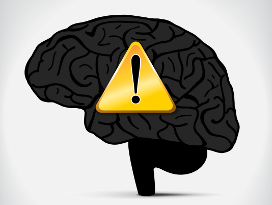 "A rapidly growing body of empirical evidence documents a multitude of ways in which liberals and conservatives differ from each other in purviews of life with little direct connection to politics, from tastes in art to desire for closure and from disgust sensitivity to the tendency to pursue new information, but the central theme of the differences is a matter of debate. "A rapidly growing body of empirical evidence documents a multitude of ways in which liberals and conservatives differ from each other in purviews of life with little direct connection to politics, from tastes in art to desire for closure and from disgust sensitivity to the tendency to pursue new information, but the central theme of the differences is a matter of debate.
In this article, we argue that one organizing element of the many differences between liberals and conservatives is the nature of their physiological and psychological responses to features of the environment that are negative.
Compared with liberals, conservatives tend to register greater physiological responses to such stimuli and also to devote more psychological resources to them...
We conclude with a discussion of normative implications, stressing that identifying differences across ideological groups is not tantamount to declaring one ideology superior to another."
John R. Hibbing, Kevin B. Smith, and John R. Alford, "Differences in Negativity Bias Underlie Variations in Political Ideology," Behavioral and Brain Sciences, June 2014 |
|
4. During risk-taking behavior, liberals have significantly greater brain activity in the left insula area, while conservatives have significantly greater brain activity in the right amygdala.
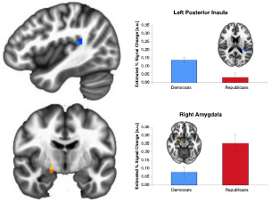 "Liberals and conservatives exhibit different cognitive styles and converging lines of evidence suggest that biology influences differences in their political attitudes and beliefs... "Liberals and conservatives exhibit different cognitive styles and converging lines of evidence suggest that biology influences differences in their political attitudes and beliefs...
Here, we explore differences in brain function in liberals and conservatives by matching publicly-available voter records to 82 subjects who performed a risk-taking task during functional imaging. Although the risk-taking behavior of Democrats (liberals) and Republicans (conservatives) did not differ, their brain activity did. Democrats showed significantly greater activity in the left insula, while Republicans showed significantly greater activity in the right amygdala.
In fact, a two parameter model of partisanship based on amygdala and insula activations yields a better fitting model of partisanship than a well-established model based on parental socialization of party identification long thought to be one of the core findings of political science.
These results suggest that liberals and conservatives engage different cognitive processes when they think about risk, and they support recent evidence that conservatives show greater sensitivity to threatening stimuli."
Darren Schreiber, Greg Fonzo, Alan N. Simmons, Christopher T. Dawes, Taru Flagan, James H. Fowler, and Martin P. Paulus, "Red Brain, Blue Brain: Evaluative Processes Differ in Democrats and Republicans,"  PLoS ONE, Feb. 2013 PLoS ONE, Feb. 2013 |
|
5. People right-of-center politically spend more time looking at unpleasant images, and people left-of-center politically spend more time looking at pleasant images.
 "We report evidence that individual-level variation in people's physiological and attentional responses to aversive and appetitive stimuli are correlated with broad political orientations. Specifically, we find that greater orientation to aversive stimuli tends to be associated with right-of-centre and greater orientation to appetitive (pleasing) stimuli with left-of-centre political inclinations." "We report evidence that individual-level variation in people's physiological and attentional responses to aversive and appetitive stimuli are correlated with broad political orientations. Specifically, we find that greater orientation to aversive stimuli tends to be associated with right-of-centre and greater orientation to appetitive (pleasing) stimuli with left-of-centre political inclinations."
Michael D. Dodd, Amanda Balzer, Carly Jacobs, Michael Gruszczynski, Kevin B. Smith, and John R. Hibbing, "The Left Rolls with the Good; The Right Confronts the Bad. Physiology and Cognition in Politics," Philosophical Transactions of the Royal Society B: Biological Sciences, Mar. 5, 2012 |
|
6. Reliance on quick, efficient, and "low effort" thought processes yields conservative ideologies, while effortful and deliberate reasoning yields liberal ideologies.
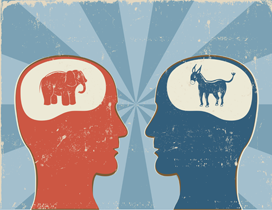 "...[P]olitical conservatism is promoted when people rely on low-effort thinking. When effortful, deliberate responding is disrupted or disengaged, thought processes become quick and efficient; these conditions promote conservative ideology… low-effort thought might promote political conservatism because its concepts are easier to process, and processing fluency increases attitude endorsement. "...[P]olitical conservatism is promoted when people rely on low-effort thinking. When effortful, deliberate responding is disrupted or disengaged, thought processes become quick and efficient; these conditions promote conservative ideology… low-effort thought might promote political conservatism because its concepts are easier to process, and processing fluency increases attitude endorsement.
Four studies support our assertion that low-effort thinking promotes political conservatism... Our findings suggest that conservative ways of thinking are basic, normal, and perhaps natural."
Scott Eidelman, Christian S. Crandall, Jeffrey A. Goodman, and John C. Blanchar, "Low-Effort Thought Promotes Political Conservatism," Society for Personality and Social Psychology, 2012 |
|
7. People who react strongly to disgusting images, such as a picture of someone eating worms, are more likely to self-identify as conservative.
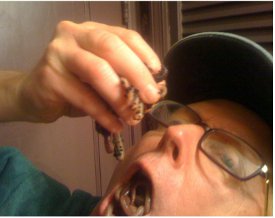 "People who believe they would be bothered by a range of hypothetical disgusting situations display an increased likelihood of displaying right-of-center rather than left-of-center political orientations… In this article, we demonstrate that individuals with marked involuntary physiological responses to disgusting images [measured by change in mean skin conductance], such as of a man eating a large mouthful of writhing worms, are more likely to self-identify as conservative and, especially, to oppose gay marriage than are individuals with more muted physiological responses to the same images." "People who believe they would be bothered by a range of hypothetical disgusting situations display an increased likelihood of displaying right-of-center rather than left-of-center political orientations… In this article, we demonstrate that individuals with marked involuntary physiological responses to disgusting images [measured by change in mean skin conductance], such as of a man eating a large mouthful of writhing worms, are more likely to self-identify as conservative and, especially, to oppose gay marriage than are individuals with more muted physiological responses to the same images."
Kevin B. Smith, Douglas Oxley, Matthew V. Hibbing, John R. Alford, and John R. Hibbing, "Disgust Sensitivity and the Neurophysiology of Left-Right Political Orientations,"  PLOS ONE, Oct. 19, 2011 PLOS ONE, Oct. 19, 2011 |
|
8. Liberals have more tolerance to uncertainty (bigger anterior cingulate cortex), and conservatives have more sensitivity to fear (bigger right amygdala).
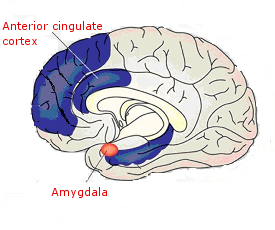 "In a large sample of young adults, we related self-reported political attitudes to gray matter volume using structural MRI [magnetic resonance imaging]. We found that greater liberalism was associated with increased gray matter volume in the anterior cingulate cortex, whereas greater conservatism was associated with increased volume of the right amygdala... "In a large sample of young adults, we related self-reported political attitudes to gray matter volume using structural MRI [magnetic resonance imaging]. We found that greater liberalism was associated with increased gray matter volume in the anterior cingulate cortex, whereas greater conservatism was associated with increased volume of the right amygdala...
...[O]ur findings are consistent with the proposal that political orientation is associated with psychological processes for managing fear and uncertainty. The amygdala has many functions, including fear processing. Individuals with a larger amygdala are more sensitive to fear, which, taken together with our findings, might suggest the testable hypothesis that individuals with larger amygdala are more inclined to integrate conservative views into their belief systems... our finding of an association between anterior cingulate cortex [ACC] may be linked with tolerance to uncertainty. One of the functions of the anterior cingulate cortex is to monitor uncertainty and conflicts. Thus it is conceivable that individuals with a larger ACC have a higher capacity to tolerate uncertainty and conflicts, allowing them to accept more liberal views."
Ryota Kanai, Tom Feilden, Colin Firth, and Geraint Rees, "Political Orientations Are Correlated with Brain Structure in Young Adults," Current Biology, Apr. 7, 2011 |
|
9. Conservatives have stronger motivations than liberals to preserve purity and cleanliness.
 "...[R]eminders of physical purity influence specific moral judgments regarding behaviors in the sexual domain as well as broad political attitudes... "...[R]eminders of physical purity influence specific moral judgments regarding behaviors in the sexual domain as well as broad political attitudes...
...[E]nvironmental reminders of physical cleanliness shifted participants’ attitudes toward the conservative end of the political spectrum and altered their specific attitudes toward various moral acts...
Conservatives show a stronger tendency than liberals to feel disgust and find specific violations of sexual purity more offensive... When taken together, these two sets of results point to the possibility that political orientation may be, in some measure, shaped by the strength of an individual’s motivation to avoid physical contamination and that resulting vigilance for threats to purity may serve to reinforce a politically conservative stance toward the world."
Erik G. Helzer and David A. Pizarro, "Dirty Liberals! Reminders of Physical Cleanliness Influence Moral and Political Attitudes," Psychological Science, Mar. 18, 2011 |
|
10. Liberals are more likely than conservatives to shift their attention in the direction of another person's gaze.
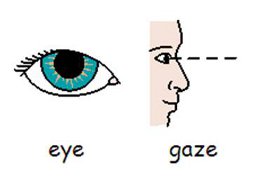 "In the present study, we examine whether gaze cue effects [shifting ones attention in the direction of another's gaze] are moderated by political temperament, given that those on the political right tend to be more supportive of individualism—and less likely to be influenced by others—than those on the left. We find standard gaze cuing effects across all subjects, but systematic differences in these effects by political temperament. Liberals exhibit a very large gaze cuing effect while conservatives show no such effect at various SOAs [stimulus onset asynchrony]... "In the present study, we examine whether gaze cue effects [shifting ones attention in the direction of another's gaze] are moderated by political temperament, given that those on the political right tend to be more supportive of individualism—and less likely to be influenced by others—than those on the left. We find standard gaze cuing effects across all subjects, but systematic differences in these effects by political temperament. Liberals exhibit a very large gaze cuing effect while conservatives show no such effect at various SOAs [stimulus onset asynchrony]...
Perhaps conservatives are less likely to trust others meaning that they are also less likely to trust a gaze cue..."
Michael D. Dodd, John R. Hibbing, and Kevin B. Smith, "The Politics of Attention: Gaze Cuing Effects Are Moderated by Political Temperament," Attention, Perception & Psychophysics, Jan. 2011 |
|
11. Republicans are more likely than Democrats to interpret faces as threatening and expressing dominant emotions, while Democrats show greater emotional distress and lower life satisfaction.
 "Independent sample t-tests revealed group differences in the averaged threat interpretation scores of the 10 facial stimuli. Republican sympathizers were more likely to interpret the faces as signaling a threatening expression as compared to Democrat sympathizers. Group differences were also found for dominance perceptions, whereby Republican sympathizers were more likely to perceive the faces as expressing dominant emotions than were Democrat sympathizers... "Independent sample t-tests revealed group differences in the averaged threat interpretation scores of the 10 facial stimuli. Republican sympathizers were more likely to interpret the faces as signaling a threatening expression as compared to Democrat sympathizers. Group differences were also found for dominance perceptions, whereby Republican sympathizers were more likely to perceive the faces as expressing dominant emotions than were Democrat sympathizers...
Collectively, when compared to Republican sympathizers, Democrat sympathizers showed greater psychological distress, more frequent histories of adverse life events such as interpersonal victimization experiences, fewer and less satisfying relationships, and lower perceptions of the trustworthiness of peers and intimate affiliates."
Jacob M. Vigil, "Political Leanings Vary with Facial Expression Processing and Psychosocial Functioning," Group Processes & Intergroup Relations, 2010 |
|
12. Conservatives and liberals react similarly to positive incentives, but conservatives have greater sensitivity to negative stimuli.
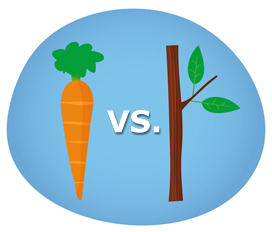 "Our findings suggest that conservatives are sensitive to avoidance motivation [motivation through negative stimuli], which produces 'inhibition' responses manifested in greater rigidity... Based on the studies' findings, we would not expect differences between liberals and conservatives in responding to positive stimuli or incentives (i.e., approach cues), but we would expect greater inhibitory reactions by conservatives in response to negative, avoidant cues. Self-regulation appears to provide a useful perspective for understanding how one's political views may affect categorization processes and, more broadly, the association between political conservatism and rigidity." "Our findings suggest that conservatives are sensitive to avoidance motivation [motivation through negative stimuli], which produces 'inhibition' responses manifested in greater rigidity... Based on the studies' findings, we would not expect differences between liberals and conservatives in responding to positive stimuli or incentives (i.e., approach cues), but we would expect greater inhibitory reactions by conservatives in response to negative, avoidant cues. Self-regulation appears to provide a useful perspective for understanding how one's political views may affect categorization processes and, more broadly, the association between political conservatism and rigidity."
Mindi S. Rock and Ronnie Janoff-Bulman, "Where Do We Draw Our Lines? Politics, Rigidity, and the Role of Self-Regulation," Social Psychological and Personality Science, Jan. 2010 |
|
13. Conservatives have more activity in their dorsolateral prefrontal cortices, the part of the brain that activates for complex social evaluations.
 "The conservatism dimension, which corresponds to the liberal-to-conservative criterion, was associated with activity in the right DLPFC [dorsolateral prefrontal cortex]... "The conservatism dimension, which corresponds to the liberal-to-conservative criterion, was associated with activity in the right DLPFC [dorsolateral prefrontal cortex]...
In this study, we speculate that activity in the DLPFC may reflect a role of this region in deliberative decision-making in complex social evaluations... The observation that this region was increasingly activated by conservative beliefs could be explained by claiming that conservative statements require more complex social judgments marked by greater cognitive dissonance between self-interest and sense of fairness...
[W]e showed that the representation of complex political beliefs relies on three fundamental dimensions, each reflected in distinctive patterns of neural activation: The degree of individualism of political beliefs was linearly associated with activation in the medial PFC [prefrontal cortex] and TPJ [temporoparietal junction], the degree of conservatism with activation in the DLPFC, and the degree of radicalism with activation in the ventral striatum and PC/P [posterior cingulate/precuneus]. Our findings support the interpretation that the political belief system depends on a set of social cognitive processes including those that enable a person to judge themselves and other people, make decisions in ambivalent social situations, and comprehend motivational and emotional states."
Giovanna Zamboni, Marta Gozzi, Frank Krueger, Jean-René Duhamel, Angela Sirigu, and Jordan Grafman, "Individualism, Conservatism, and Radicalism As Criteria for Processing Political Beliefs: A Parametric fMRI Study," Social Neuroscience, Sep. 2009 |
|
14. Conservatism is focused on preventing negative outcomes, while liberalism is focused on advancing positive outcomes.
 "Political liberalism and conservatism differ in provide versus protect orientations, specifically providing for group members' welfare (political Left) and protecting the group from harm (political Right). These reflect the fundamental psychological distinction between approach and avoidance motivation. Conservatism is avoidance based; it is focused on preventing negative outcomes (e.g., societal losses) and seeks to regulate society via inhibition (restraints) in the interests of social order. Liberalism is approach based; it is focused on advancing positive outcomes (e.g., societal gains) and seeks to regulate society via activation (interventions) in the interests of social justice." "Political liberalism and conservatism differ in provide versus protect orientations, specifically providing for group members' welfare (political Left) and protecting the group from harm (political Right). These reflect the fundamental psychological distinction between approach and avoidance motivation. Conservatism is avoidance based; it is focused on preventing negative outcomes (e.g., societal losses) and seeks to regulate society via inhibition (restraints) in the interests of social order. Liberalism is approach based; it is focused on advancing positive outcomes (e.g., societal gains) and seeks to regulate society via activation (interventions) in the interests of social justice."
Ronnie Janoff-Bulman, "To Provide or Protect: Motivational Bases of Political Liberalism and Conservatism," Psychological Inquiry: An International Journal for the Advancement of Psychological Theory, Aug. 2009 |
|
15. Genetics influence political attitudes during early adulthood and beyond.
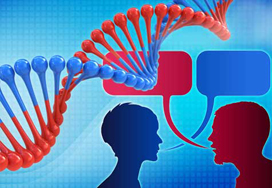 "The present research attempts to characterize how the transmission of political orientations develops over the life course... [G]enetic influences on political attitudes are absent prior to young adulthood. During childhood and adolescence, individual differences in political attitudes are accounted for by a variety of environmental influences... However, at the point of early adulthood (in the early 20s), for those who left their parental home, there is evidence of a sizeable genetic influence on political attitudes which remains stable throughout adult life." "The present research attempts to characterize how the transmission of political orientations develops over the life course... [G]enetic influences on political attitudes are absent prior to young adulthood. During childhood and adolescence, individual differences in political attitudes are accounted for by a variety of environmental influences... However, at the point of early adulthood (in the early 20s), for those who left their parental home, there is evidence of a sizeable genetic influence on political attitudes which remains stable throughout adult life."
Peter K. Hatemi, Carolyn L. Funk, Sarah E. Medland, Hermine M. Maes, Judy L. Silberg, Nicholas G. Martin, and Lindon J. Eaves, "Genetic and Environmental Transmission of Political Attitudes Over a Life Time," The Journal of Politics, July 21, 2009 |
|
16. Conservatives learn better from negative stimuli than from positive stimuli and are more risk avoidant than liberals.
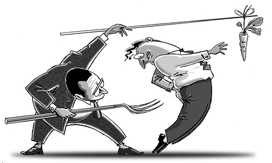 "In this study, the relations among political ideology, exploratory behavior, and the formation of attitudes toward novel stimuli were explored. Participants played a computer game that required learning whether these stimuli produced positive or negative outcomes. Learning was dependent on participants’ decisions to sample novel stimuli... Political ideology correlated with exploration during the game, with conservatives sampling fewer targets than liberals. Moreover, more conservative individuals exhibited a stronger learning asymmetry, such that they learned negative stimuli better than positive... Relative to liberals, politically conservative individuals pursued a more avoidant strategy to the game… "In this study, the relations among political ideology, exploratory behavior, and the formation of attitudes toward novel stimuli were explored. Participants played a computer game that required learning whether these stimuli produced positive or negative outcomes. Learning was dependent on participants’ decisions to sample novel stimuli... Political ideology correlated with exploration during the game, with conservatives sampling fewer targets than liberals. Moreover, more conservative individuals exhibited a stronger learning asymmetry, such that they learned negative stimuli better than positive... Relative to liberals, politically conservative individuals pursued a more avoidant strategy to the game…
The reluctance to explore that characterizes more politically conservative individuals may protect them from experiencing negative situations, for they are likely to restrict approach to known positives."
Natalie J. Shook and Russell H. Fazio, "Political Ideology, Exploration of Novel Stimuli, and Attitude Formation," Experimental Social Psychology, Apr. 3, 2009 |
|
17. Individual political attitudes correlate with physiological traits, such as sensitivity to sudden noises and threatening visual images.
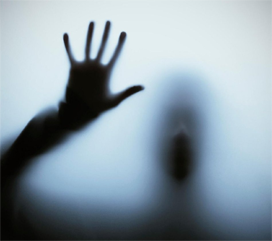 "We present evidence that variations in political attitudes correlate with physiological traits... "We present evidence that variations in political attitudes correlate with physiological traits...
In a group of 46 adult participants with strong political beliefs, individuals with measurably lower physical sensitivities to sudden noises and threatening visual images were more likely to support foreign aid, liberal immigration policies, pacifism, and gun control, whereas individuals displaying measurably higher physiological reactions to those same stimuli were more likely to favor defense spending, capital punishment, patriotism, and the Iraq War. Thus, the degree to which individuals are physiologically responsive to threat appears to indicate the degree to which they advocate policies that protect the existing social structure from both external (outgroup) and internal (norm-violator) threats...
We do not label these collections of policy positions as either 'liberal' or 'conservative' because we measure only one aspect of ideologies and exclude other aspects such as positions on economic issues. We take no stance on whether these positions actually promote the stability and cohesion of the social unit; we only assert that, given the common frames of the modern American policy, those most concerned about social protection will tend to be attracted to the particular policy positions listed."
Douglas R. Oxley, Kevin B. Smith, John R. Alford, Matthew V. Hibbing, Jennifer L. Miller, Mario Scalora, Peter K. Hatemi, and John R. Hibbing, "Political Attitudes Vary with Physiological Traits," Science, Sep. 19, 2008 |
|
18. Liberals are more open-minded and creative whereas conservatives are more orderly and better organized.
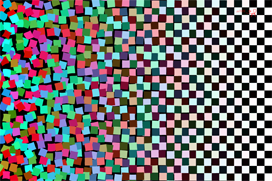 "We obtained consistent and converging evidence that personality differences between liberals and conservatives are robust, replicable, and behaviorally significant, especially with respect to social (vs. economic) dimensions of ideology. In general, liberals are more open-minded, creative, curious, and novelty seeking, whereas conservatives are more orderly, conventional, and better organized... A special advantage of our final two studies is that they show personality differences between liberals and conservatives not only on self-report trait measures but also on unobtrusive, nonverbal measures of interaction style and behavioral residue.” "We obtained consistent and converging evidence that personality differences between liberals and conservatives are robust, replicable, and behaviorally significant, especially with respect to social (vs. economic) dimensions of ideology. In general, liberals are more open-minded, creative, curious, and novelty seeking, whereas conservatives are more orderly, conventional, and better organized... A special advantage of our final two studies is that they show personality differences between liberals and conservatives not only on self-report trait measures but also on unobtrusive, nonverbal measures of interaction style and behavioral residue.”
Dana R. Carney, John T. Jost, Samuel D. Gosling, and Jeff Potter, "The Secret Lives of Liberals and Conservatives: Personality Profiles, Interaction Styles, and the Things They Leave Behind," International Society of Political Psychology, Oct. 23, 2008 |
|
19. When faced with a conflict, liberals are more likely than conservatives to alter their habitual response when cues indicate it is necessary.
 "[We] found that greater liberalism was associated with stronger conflict-related anterior cingulate activity, suggesting greater neurocognitive sensitivity to cues for altering a habitual response pattern... "[We] found that greater liberalism was associated with stronger conflict-related anterior cingulate activity, suggesting greater neurocognitive sensitivity to cues for altering a habitual response pattern...
Our results are consistent with the view that political orientation, in part, reflects individual differences in the functioning of a general mechanism related to cognitive control and self-regulation. Stronger conservatism (versus liberalism) was associated with less neurocognitive sensitivity to response conflicts. At the behavioral level, conservatives were also more likely to make errors of commission. Although a liberal orientation was associated with better performance on the response-inhibition task examined here, conservatives would presumably perform better on tasks in which a more fixed response style is optimal."
David M. Amodio, John T. Jost, Sarah L. Master, and Cindy M. Yee, "Neurocognitive Correlates of Liberalism and Conservatism," Nature Neuroscience, Sep. 9, 2007 |
|
20. Conservatives sleep more soundly and have more mundane dreams, while liberals sleep more restlessly and have a more bizarre, active dream life.
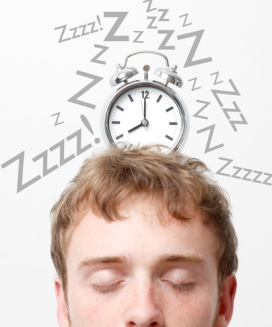 "Conservatives slept somewhat more soundly, with fewer remembered dreams. Liberals were more restless in their sleep and had a more active and varied dream life. In contrast to a previous study, liberals reported a somewhat greater proportion of bad dreams and nightmares. Consistent with earlier research, the dreams of conservatives were more mundane, whereas the dreams of liberals were more bizarre... "Conservatives slept somewhat more soundly, with fewer remembered dreams. Liberals were more restless in their sleep and had a more active and varied dream life. In contrast to a previous study, liberals reported a somewhat greater proportion of bad dreams and nightmares. Consistent with earlier research, the dreams of conservatives were more mundane, whereas the dreams of liberals were more bizarre...
Conservative men sleep a bit longer, with better quality sleep; they recall the fewest dreams, but have the most lucid awareness. Liberal women have the worst quality sleep, recall the greatest number and variety of dreams, and have the most dream references to homosexuality."
Kelly Bulkeley, "Sleep and Dream patterns of Political Liberals and Conservatives," Dreaming, Sep. 2006 |
|
|
|
RECOMMENDED to you...
|
|
1
|
|
2
|
|
3
|
|
4
|
|
5
|
|
6
|
|
7
|
|
8
|
|
9
|
|
10
|
|
11
|
|
12
|
|
|
|

CITE THIS PAGE
Who is the author?
|
|
SHARE
|
|